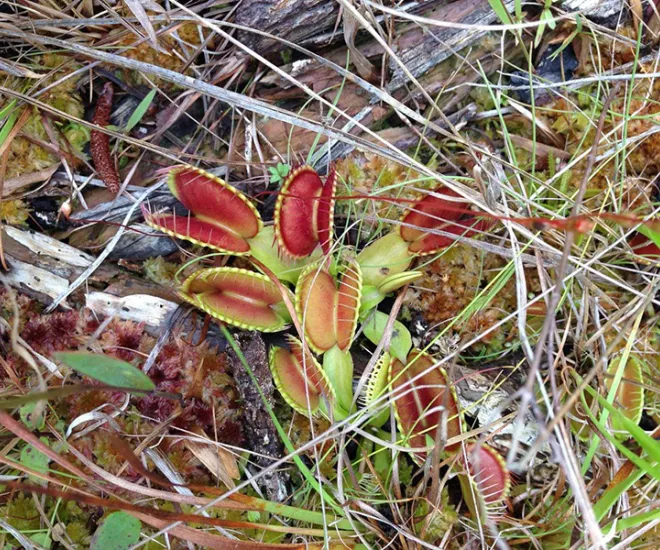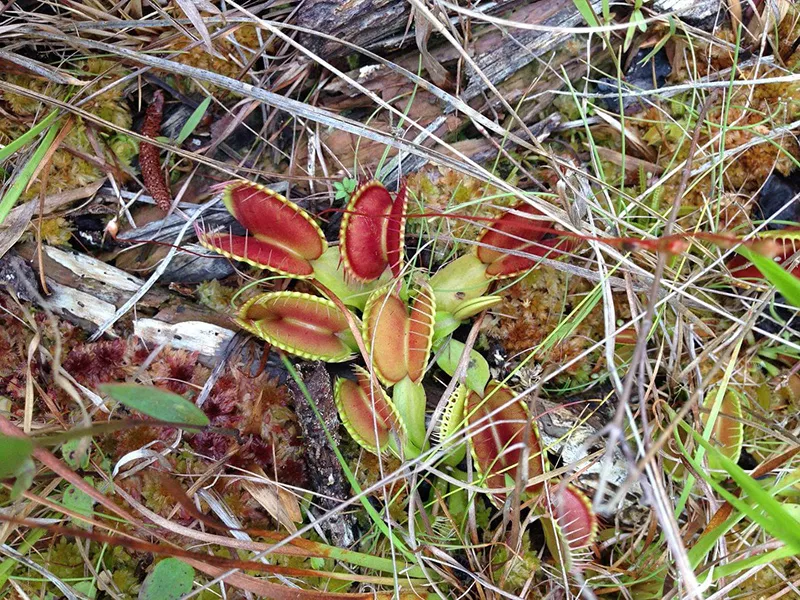Find Venus Fly Traps in Myrtle Beach

The Mysterious Little Plants That Got Their Start Near Myrtle Beach
Did Venus flytraps come from outer space? The mysterious little plant that shares a name with the second planet from the sun is known the world over. While it has been introduced into the wild in such places as Florida and New Jersey, it is indigenous to only a 75-mile span that straddles the border of North and South Carolina which includes the Carolina Bays, just outside of Myrtle Beach.
Since the 1930s and particularly in the 1950s, scientists have claimed that the Carolina Bays were the result of a meteor shower. That theory has even trickled down to the pages of school children’s textbooks. So maybe seeds for this most unusual of plants hitched a ride from some unknown cosmic origin and landed to grow in literally our own backyard.
If you would like to try to see these little wonders in the wild, your best opportunity would be to visit the Lewis Ocean Bay Heritage Preserve which is accessed from International Drive, between Myrtle Beach and Conway. Be forewarned, that preserve has 10,427 acres, and those little flycatchers are difficult to find. But if you enjoy walking or biking in the woods, what better excuse to do so than to be on a quest for this elusive plant?

March through June would be the best time to try. But if you do actually find one, take a photograph of it because you will have just accomplished something many have failed to do. Also make sure that a photograph is the only thing you take because there are stiff penalties for removing Venus flytraps from public lands.
In South Carolina, the Venus flytrap was added to a law in 2013 previously devoted to the protection of sea oats. It now reads that “It shall be unlawful for any person to cut, collect, break or otherwise destroy sea oat plants, Venus's-flytrap plants or any part on public property or on private property without the owner's consent.
Any person violating the provisions of this section shall be guilty of a misdemeanor and upon conviction shall be fined not more than two hundred dollars or imprisoned not more than thirty days nor less than five days. Each violation shall constitute a separate offense.”
Our state legislature takes seriously the protection of these plants that are classified as vulnerable but may reach endangered species status in the not too distant future. Who has taken an even tougher stance in regard to their protection? North Carolina: in 2014, they made their illegal poaching on public land a Class H felony. Taking them from someone’s private land without permission is also a felony.
In the most dramatic case to date, a man may spend the rest of his life in prison for poaching 216 Venus flytrap plants out of the Green Swamp Game Land in Bolivia, North Carolina. He was held in the Brunswick County jail on a $750,000 secured bond after being charged with 216 felony counts. If each count is prosecuted, he would be looking at a sentence of 72 to 450 years in prison.
So what is the backstory on this exotic flora that may themselves be aliens to our planet, and lure people to risk their life’s freedom to procure? There’s no telling when their story actually began, but the first record of their existence dates back to the 1750s. That was when the North Carolina Governor, Arthur Hobbs, who made his home in Brunswick County first discovered it and noted how unusual it was.
He was an amateur botanist and, perhaps due to his political influence, managed to get the attention of the leading professional botanists of the day. In 1759, he had his son hand-deliver a letter to the British naturalist, Peter Collinson, which was how Europe was introduced to the knowledge of the Venus flytrap’s existence.
But it didn’t have a name at that point. Well, it didn’t have a real name. The nickname that was placed on it almost immediately by the British who knew about it was the Tippitywichit.
It received its official moniker afterwards from another prominent naturalist in London, John Ellis, who came up with two choices: Venus’s Flytrap or Venus’s Mousetrap. I presume that he went with the former as the latter was a bit misleading (and scary). A bug killer is one thing, but a plant that can devour mammals is quite another. The scientific name that he devised for it was Dionaea muscipula.
But why did he name it after the Roman goddess of love and beauty, Venus, as opposed to, let’s say, Diana, the Roman goddess of wild animals and the hunt? Or was he naming it after the planet Venus that had first been observed by Galileo in 1610? Did he suspect that the plant’s origin was other-worldly?
Probably not as that theory really couldn’t have taken off until the 1930s when aviators first discovered that the relatively small area where these plants are found included the Carolina Bays that may have been created by a meteor shower. While these unique geological features existed in Ellis’ time, no one realized it until they were observed from the air.
Even today, when you are driving along South Carolina Highway 31 (aka The Carolina Bays Parkway), which is one of the most efficient ways to enter and exit the Myrtle Beach area, or visiting the Lewis Ocean Bay Heritage Preserve, you can’t tell if you are in or near one of these 23 unusual elliptical depressions known as the Carolina Bays. Their sizes range from just a few acres to literally thousands of acres. Each tends to be filled with wetlands that retain rainwater in the cooler months and dry out in the summer. They serve as a home for a large variety of vegetation including our little flytraps.
The most significant feature that they share is that they are all aligned in the same direction, a northwest to southeast orientation. They are sometimes referred to as the crop circles of the wetlands. It is that particular orientation that has fueled the theory that they were created by meteors slamming into the Eastern Seaboard. Similar depressions exist in Maryland where they are called the Maryland Basins. And within the Delmarva Peninsula, also called the Eastern Shore, that is shared by Delaware, Maryland and Virginia, where they are called the Delmarva Bays. The bay trees that grow in and near the depressions are referenced in their name and ours.
While similar, only the Carolina Bays have Venus flytraps. It’s our sandy soil with its lack of nutrients that necessitates the plants’ need to seek nourishment elsewhere. A Venus flytrap enthusiast told me that if you put the plant in nutrient-rich soil, it will die.
Their diets include insects and arachnids, the likes of ants, beetles, grasshoppers, spiders and, of course, flies. It may take three to five days to consume its prey, but it won’t need to feed again for a month or so. Most of their energy actually comes from photosynthesis. These carnivorous perennials can live up to twenty years in their natural habitat.
Was that habitat created by meteors? Well, scientists since the 1950s don’t think so. Tests show that the depressions aren’t deep enough to be consistent with known craters, that no meteorite fragments have been found near or in them, and that they were created at different times so we know that they were not the result of a singular event. Other popular theories of their formation that haven’t been substantiated either are sinkholes, water coming up from below ground, water currents when the land was underneath the ocean, and wind patterns.
It would have been exciting to discover that Venus flytraps did ride in on a meteor to find a home near Myrtle Beach. But the fact that we don’t know how the Carolina Bays were formed or how our Venus flytraps came to be here-- and only here-- makes their existence all the more fascinating.
